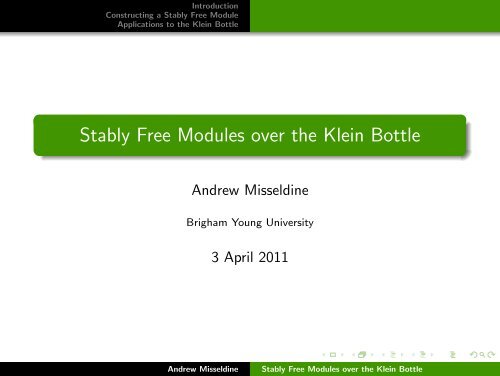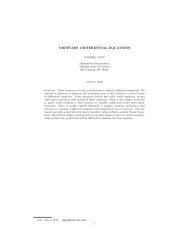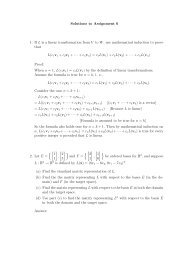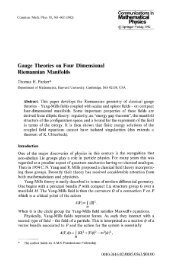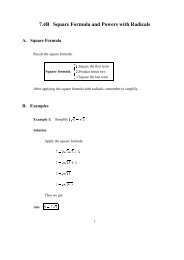Stably Free Modules over the Klein Bottle
Stably Free Modules over the Klein Bottle
Stably Free Modules over the Klein Bottle
Create successful ePaper yourself
Turn your PDF publications into a flip-book with our unique Google optimized e-Paper software.
Introduction<br />
Constructing a <strong>Stably</strong> <strong>Free</strong> Module<br />
Applications to <strong>the</strong> <strong>Klein</strong> <strong>Bottle</strong><br />
<strong>Stably</strong> <strong>Free</strong> <strong>Modules</strong> <strong>over</strong> <strong>the</strong> <strong>Klein</strong> <strong>Bottle</strong><br />
Andrew Misseldine<br />
Brigham Young University<br />
3 April 2011<br />
Andrew Misseldine <strong>Stably</strong> <strong>Free</strong> <strong>Modules</strong> <strong>over</strong> <strong>the</strong> <strong>Klein</strong> <strong>Bottle</strong>
Introduction<br />
Constructing a <strong>Stably</strong> <strong>Free</strong> Module<br />
Applications to <strong>the</strong> <strong>Klein</strong> <strong>Bottle</strong><br />
Polynomials<br />
Definition - Skew Laurent Polynomials<br />
Let R be a ring and let σ : R → R be a ring isomorphism.<br />
A skew Laurent polynomial is a polynomial which allows negative<br />
exponents for <strong>the</strong> indeterminate x and with <strong>the</strong> relation that<br />
xr = σ(r)x, ∀r ∈ R.<br />
Andrew Misseldine <strong>Stably</strong> <strong>Free</strong> <strong>Modules</strong> <strong>over</strong> <strong>the</strong> <strong>Klein</strong> <strong>Bottle</strong>
Introduction<br />
Constructing a <strong>Stably</strong> <strong>Free</strong> Module<br />
Applications to <strong>the</strong> <strong>Klein</strong> <strong>Bottle</strong><br />
Polynomials<br />
Definition - Skew Laurent Polynomials<br />
Let R be a ring and let σ : R → R be a ring isomorphism.<br />
A skew Laurent polynomial is a polynomial which allows negative<br />
exponents for <strong>the</strong> indeterminate x and with <strong>the</strong> relation that<br />
xr = σ(r)x, ∀r ∈ R.<br />
Andrew Misseldine <strong>Stably</strong> <strong>Free</strong> <strong>Modules</strong> <strong>over</strong> <strong>the</strong> <strong>Klein</strong> <strong>Bottle</strong>
Introduction<br />
Constructing a <strong>Stably</strong> <strong>Free</strong> Module<br />
Applications to <strong>the</strong> <strong>Klein</strong> <strong>Bottle</strong><br />
Polynomials<br />
Definition - Skew Laurent Polynomials<br />
Let R be a ring and let σ : R → R be a ring isomorphism.<br />
A skew Laurent polynomial is a polynomial which allows negative<br />
exponents for <strong>the</strong> indeterminate x and with <strong>the</strong> relation that<br />
xr = σ(r)x, ∀r ∈ R.<br />
Andrew Misseldine <strong>Stably</strong> <strong>Free</strong> <strong>Modules</strong> <strong>over</strong> <strong>the</strong> <strong>Klein</strong> <strong>Bottle</strong>
Introduction<br />
Constructing a <strong>Stably</strong> <strong>Free</strong> Module<br />
Applications to <strong>the</strong> <strong>Klein</strong> <strong>Bottle</strong><br />
Polynomials<br />
Definition - Skew Laurent Polynomials<br />
Let R be a ring and let σ : R → R be a ring isomorphism.<br />
A skew Laurent polynomial is a polynomial which allows negative<br />
exponents for <strong>the</strong> indeterminate x and with <strong>the</strong> relation that<br />
xr = σ(r)x, ∀r ∈ R.<br />
Then <strong>the</strong> collection of all skew Laurent polynomials with<br />
coefficients from R is a ring.<br />
Denote this ring as<br />
R[x, x −1 ; σ].<br />
Andrew Misseldine <strong>Stably</strong> <strong>Free</strong> <strong>Modules</strong> <strong>over</strong> <strong>the</strong> <strong>Klein</strong> <strong>Bottle</strong>
Introduction<br />
Constructing a <strong>Stably</strong> <strong>Free</strong> Module<br />
Applications to <strong>the</strong> <strong>Klein</strong> <strong>Bottle</strong><br />
Projective <strong>Modules</strong><br />
Definition - <strong>Stably</strong> <strong>Free</strong> Module<br />
An R-module P is stably free iff <strong>the</strong>re exists natural numbers m, n<br />
such that P ⊕ R m ∼ = R n .<br />
{<strong>Free</strong> <strong>Modules</strong>} ⊆ {<strong>Stably</strong> <strong>Free</strong> <strong>Modules</strong>} ⊆ {Projective <strong>Modules</strong>}<br />
Andrew Misseldine <strong>Stably</strong> <strong>Free</strong> <strong>Modules</strong> <strong>over</strong> <strong>the</strong> <strong>Klein</strong> <strong>Bottle</strong>
Introduction<br />
Constructing a <strong>Stably</strong> <strong>Free</strong> Module<br />
Applications to <strong>the</strong> <strong>Klein</strong> <strong>Bottle</strong><br />
Projective <strong>Modules</strong><br />
Definition - <strong>Stably</strong> <strong>Free</strong> Module<br />
An R-module P is stably free iff <strong>the</strong>re exists natural numbers m, n<br />
such that P ⊕ R m ∼ = R n .<br />
{<strong>Free</strong> <strong>Modules</strong>} ⊆ {<strong>Stably</strong> <strong>Free</strong> <strong>Modules</strong>} ⊆ {Projective <strong>Modules</strong>}<br />
Andrew Misseldine <strong>Stably</strong> <strong>Free</strong> <strong>Modules</strong> <strong>over</strong> <strong>the</strong> <strong>Klein</strong> <strong>Bottle</strong>
Introduction<br />
Constructing a <strong>Stably</strong> <strong>Free</strong> Module<br />
Applications to <strong>the</strong> <strong>Klein</strong> <strong>Bottle</strong><br />
This is a <strong>Klein</strong> <strong>Bottle</strong><br />
Andrew Misseldine <strong>Stably</strong> <strong>Free</strong> <strong>Modules</strong> <strong>over</strong> <strong>the</strong> <strong>Klein</strong> <strong>Bottle</strong>
Introduction<br />
Constructing a <strong>Stably</strong> <strong>Free</strong> Module<br />
Applications to <strong>the</strong> <strong>Klein</strong> <strong>Bottle</strong><br />
This is a <strong>Klein</strong> <strong>Bottle</strong><br />
x ❄<br />
•<br />
v0<br />
✲ y<br />
✛<br />
y<br />
X<br />
x<br />
❄<br />
Andrew Misseldine <strong>Stably</strong> <strong>Free</strong> <strong>Modules</strong> <strong>over</strong> <strong>the</strong> <strong>Klein</strong> <strong>Bottle</strong>
Introduction<br />
Constructing a <strong>Stably</strong> <strong>Free</strong> Module<br />
Applications to <strong>the</strong> <strong>Klein</strong> <strong>Bottle</strong><br />
This is a <strong>Klein</strong> <strong>Bottle</strong><br />
x ❄<br />
•<br />
v0<br />
✲ y<br />
✛<br />
y<br />
We see from <strong>the</strong> fundamental square, that<br />
Call this group G.<br />
X<br />
x<br />
❄<br />
π(X , v0) = 〈x, y | x −1 yx = y −1 〉<br />
= 〈x, y | yx = xy −1 〉<br />
Andrew Misseldine <strong>Stably</strong> <strong>Free</strong> <strong>Modules</strong> <strong>over</strong> <strong>the</strong> <strong>Klein</strong> <strong>Bottle</strong>
Introduction<br />
Constructing a <strong>Stably</strong> <strong>Free</strong> Module<br />
Applications to <strong>the</strong> <strong>Klein</strong> <strong>Bottle</strong><br />
This is a <strong>Klein</strong> <strong>Bottle</strong><br />
x ❄<br />
•<br />
v0<br />
✲ y<br />
✛<br />
y<br />
We see from <strong>the</strong> fundamental square, that<br />
Call this group G.<br />
X<br />
x<br />
❄<br />
π(X , v0) = 〈x, y | x −1 yx = y −1 〉<br />
= 〈x, y | yx = xy −1 〉<br />
Andrew Misseldine <strong>Stably</strong> <strong>Free</strong> <strong>Modules</strong> <strong>over</strong> <strong>the</strong> <strong>Klein</strong> <strong>Bottle</strong>
Introduction<br />
Constructing a <strong>Stably</strong> <strong>Free</strong> Module<br />
Applications to <strong>the</strong> <strong>Klein</strong> <strong>Bottle</strong><br />
This is a <strong>Klein</strong> <strong>Bottle</strong><br />
x ❄<br />
•<br />
v0<br />
✲ y<br />
✛<br />
y<br />
We see from <strong>the</strong> fundamental square, that<br />
Call this group G.<br />
X<br />
x<br />
❄<br />
π(X , v0) = 〈x, y | x −1 yx = y −1 〉<br />
= 〈x, y | yx = xy −1 〉<br />
Andrew Misseldine <strong>Stably</strong> <strong>Free</strong> <strong>Modules</strong> <strong>over</strong> <strong>the</strong> <strong>Klein</strong> <strong>Bottle</strong>
Introduction<br />
Constructing a <strong>Stably</strong> <strong>Free</strong> Module<br />
Applications to <strong>the</strong> <strong>Klein</strong> <strong>Bottle</strong><br />
This is a <strong>Klein</strong> <strong>Bottle</strong><br />
x ❄<br />
•<br />
v0<br />
✲ y<br />
✛<br />
y<br />
We see from <strong>the</strong> fundamental square, that<br />
Call this group G.<br />
X<br />
x<br />
❄<br />
π(X , v0) = 〈x, y | x −1 yx = y −1 〉<br />
= 〈x, y | yx = xy −1 〉<br />
Andrew Misseldine <strong>Stably</strong> <strong>Free</strong> <strong>Modules</strong> <strong>over</strong> <strong>the</strong> <strong>Klein</strong> <strong>Bottle</strong>
Introduction<br />
Constructing a <strong>Stably</strong> <strong>Free</strong> Module<br />
Applications to <strong>the</strong> <strong>Klein</strong> <strong>Bottle</strong><br />
This is a <strong>Klein</strong> <strong>Bottle</strong><br />
x ❄<br />
•<br />
v0<br />
✲ y<br />
✛<br />
y<br />
We see from <strong>the</strong> fundamental square, that<br />
Call this group G.<br />
X<br />
x<br />
❄<br />
π(X , v0) = 〈x, y | x −1 yx = y −1 〉<br />
= 〈x, y | yx = xy −1 〉<br />
Andrew Misseldine <strong>Stably</strong> <strong>Free</strong> <strong>Modules</strong> <strong>over</strong> <strong>the</strong> <strong>Klein</strong> <strong>Bottle</strong>
Introduction<br />
Constructing a <strong>Stably</strong> <strong>Free</strong> Module<br />
Applications to <strong>the</strong> <strong>Klein</strong> <strong>Bottle</strong><br />
The Ring ZG<br />
In light of <strong>the</strong> presentation of G,<br />
ZG = Z[y, y −1 ][x, x −1 ; σ]<br />
and σ is <strong>the</strong> isomorphism induced by<br />
σ : y ↦−→ y −1 .<br />
Andrew Misseldine <strong>Stably</strong> <strong>Free</strong> <strong>Modules</strong> <strong>over</strong> <strong>the</strong> <strong>Klein</strong> <strong>Bottle</strong>
Introduction<br />
Constructing a <strong>Stably</strong> <strong>Free</strong> Module<br />
Applications to <strong>the</strong> <strong>Klein</strong> <strong>Bottle</strong><br />
The Ring ZG<br />
In light of <strong>the</strong> presentation of G,<br />
ZG = Z[y, y −1 ][x, x −1 ; σ]<br />
and σ is <strong>the</strong> isomorphism induced by<br />
In particular,<br />
as polynomials in Z[y, y −1 ].<br />
σ : y ↦−→ y −1 .<br />
yn = ny, ∀n ∈ Z<br />
Andrew Misseldine <strong>Stably</strong> <strong>Free</strong> <strong>Modules</strong> <strong>over</strong> <strong>the</strong> <strong>Klein</strong> <strong>Bottle</strong>
Introduction<br />
Constructing a <strong>Stably</strong> <strong>Free</strong> Module<br />
Applications to <strong>the</strong> <strong>Klein</strong> <strong>Bottle</strong><br />
The Ring ZG<br />
In light of <strong>the</strong> presentation of G,<br />
ZG = Z[y, y −1 ][x, x −1 ; σ]<br />
and σ is <strong>the</strong> isomorphism induced by<br />
In particular,<br />
as polynomials in ZG.<br />
σ : y ↦−→ y −1 .<br />
yn = ny, ∀n ∈ Z<br />
xn = nx, ∀n ∈ Z<br />
yx = xy −1<br />
Andrew Misseldine <strong>Stably</strong> <strong>Free</strong> <strong>Modules</strong> <strong>over</strong> <strong>the</strong> <strong>Klein</strong> <strong>Bottle</strong>
Introduction<br />
Constructing a <strong>Stably</strong> <strong>Free</strong> Module<br />
Applications to <strong>the</strong> <strong>Klein</strong> <strong>Bottle</strong><br />
The Ring ZG<br />
In light of <strong>the</strong> presentation of G,<br />
ZG = Z[y, y −1 ][x, x −1 ; σ]<br />
and σ is <strong>the</strong> isomorphism induced by<br />
In particular,<br />
as polynomials in ZG.<br />
σ : y ↦−→ y −1 .<br />
yn = ny, ∀n ∈ Z<br />
xn = nx, ∀n ∈ Z<br />
yx = xy −1<br />
Andrew Misseldine <strong>Stably</strong> <strong>Free</strong> <strong>Modules</strong> <strong>over</strong> <strong>the</strong> <strong>Klein</strong> <strong>Bottle</strong>
Introduction<br />
Constructing a <strong>Stably</strong> <strong>Free</strong> Module<br />
Applications to <strong>the</strong> <strong>Klein</strong> <strong>Bottle</strong><br />
The ZG-module K<br />
Let<br />
r = 1 + y + y 3 ∈ ZG,<br />
s = 1 + y −1 + y −3 ∈ ZG.<br />
Andrew Misseldine <strong>Stably</strong> <strong>Free</strong> <strong>Modules</strong> <strong>over</strong> <strong>the</strong> <strong>Klein</strong> <strong>Bottle</strong>
Introduction<br />
Constructing a <strong>Stably</strong> <strong>Free</strong> Module<br />
Applications to <strong>the</strong> <strong>Klein</strong> <strong>Bottle</strong><br />
The ZG-module K<br />
Let<br />
Let<br />
r = 1 + y + y 3 ∈ ZG,<br />
s = 1 + y −1 + y −3 ∈ ZG.<br />
K = (r) ∩ (x + s)<br />
Andrew Misseldine <strong>Stably</strong> <strong>Free</strong> <strong>Modules</strong> <strong>over</strong> <strong>the</strong> <strong>Klein</strong> <strong>Bottle</strong>
Introduction<br />
Constructing a <strong>Stably</strong> <strong>Free</strong> Module<br />
Applications to <strong>the</strong> <strong>Klein</strong> <strong>Bottle</strong><br />
The ZG-module K<br />
Let<br />
Let<br />
r = 1 + y + y 3 ∈ ZG,<br />
s = 1 + y −1 + y −3 ∈ ZG.<br />
K = (r) ∩ (x + s)<br />
= rx 2 − sr 2 , rs(x + s) <br />
Andrew Misseldine <strong>Stably</strong> <strong>Free</strong> <strong>Modules</strong> <strong>over</strong> <strong>the</strong> <strong>Klein</strong> <strong>Bottle</strong>
Introduction<br />
Constructing a <strong>Stably</strong> <strong>Free</strong> Module<br />
Applications to <strong>the</strong> <strong>Klein</strong> <strong>Bottle</strong><br />
The ZG-module K<br />
Let<br />
Let<br />
r = 1 + y + y 3 ∈ ZG,<br />
s = 1 + y −1 + y −3 ∈ ZG.<br />
K = (r) ∩ (x + s)<br />
= rx 2 − sr 2 , rs(x + s) <br />
Let π : ZG ⊕ ZG → ZG as<br />
<br />
f1<br />
π = rf1 + (x + s)f2.<br />
f2<br />
Andrew Misseldine <strong>Stably</strong> <strong>Free</strong> <strong>Modules</strong> <strong>over</strong> <strong>the</strong> <strong>Klein</strong> <strong>Bottle</strong>
Introduction<br />
Constructing a <strong>Stably</strong> <strong>Free</strong> Module<br />
Applications to <strong>the</strong> <strong>Klein</strong> <strong>Bottle</strong><br />
K is <strong>Stably</strong> <strong>Free</strong><br />
Theorem (Exactness)<br />
The sequence 0 −→ K −→ ZG ⊕ ZG π<br />
−−−→ ZG −→ 0 is exact,<br />
that is, <strong>the</strong> map π : ZG 2 → ZG is surjective and ker π ∼ = K.<br />
Andrew Misseldine <strong>Stably</strong> <strong>Free</strong> <strong>Modules</strong> <strong>over</strong> <strong>the</strong> <strong>Klein</strong> <strong>Bottle</strong>
Introduction<br />
Constructing a <strong>Stably</strong> <strong>Free</strong> Module<br />
Applications to <strong>the</strong> <strong>Klein</strong> <strong>Bottle</strong><br />
K is <strong>Stably</strong> <strong>Free</strong><br />
Theorem (Exactness)<br />
The sequence 0 −→ K −→ ZG ⊕ ZG π<br />
−−−→ ZG −→ 0 is exact,<br />
that is, <strong>the</strong> map π : ZG 2 → ZG is surjective and ker π ∼ = K.<br />
Thus, ZG 2 K ∼ = ZG. Since ZG is free, <strong>the</strong> sequence splits and we<br />
have that<br />
K ⊕ ZG ∼ = ZG 2 .<br />
Andrew Misseldine <strong>Stably</strong> <strong>Free</strong> <strong>Modules</strong> <strong>over</strong> <strong>the</strong> <strong>Klein</strong> <strong>Bottle</strong>
Introduction<br />
Constructing a <strong>Stably</strong> <strong>Free</strong> Module<br />
Applications to <strong>the</strong> <strong>Klein</strong> <strong>Bottle</strong><br />
K is <strong>Stably</strong> <strong>Free</strong><br />
Theorem (Exactness)<br />
The sequence 0 −→ K −→ ZG ⊕ ZG π<br />
−−−→ ZG −→ 0 is exact,<br />
that is, <strong>the</strong> map π : ZG 2 → ZG is surjective and ker π ∼ = K.<br />
Thus, ZG 2 K ∼ = ZG. Since ZG is free, <strong>the</strong> sequence splits and we<br />
have that<br />
K ⊕ ZG ∼ = ZG 2 .<br />
Corollary<br />
K is a stably free ZG-module.<br />
Andrew Misseldine <strong>Stably</strong> <strong>Free</strong> <strong>Modules</strong> <strong>over</strong> <strong>the</strong> <strong>Klein</strong> <strong>Bottle</strong>
Introduction<br />
Constructing a <strong>Stably</strong> <strong>Free</strong> Module<br />
Applications to <strong>the</strong> <strong>Klein</strong> <strong>Bottle</strong><br />
K is <strong>Stably</strong> <strong>Free</strong><br />
Theorem (Exactness)<br />
The sequence 0 −→ K −→ ZG ⊕ ZG π<br />
−−−→ ZG −→ 0 is exact,<br />
that is, <strong>the</strong> map π : ZG 2 → ZG is surjective and ker π ∼ = K.<br />
Define : ZG → ZG ⊕ ZG as<br />
<br />
=<br />
sx −2<br />
x −1 − rx −2<br />
Andrew Misseldine <strong>Stably</strong> <strong>Free</strong> <strong>Modules</strong> <strong>over</strong> <strong>the</strong> <strong>Klein</strong> <strong>Bottle</strong>
Introduction<br />
Constructing a <strong>Stably</strong> <strong>Free</strong> Module<br />
Applications to <strong>the</strong> <strong>Klein</strong> <strong>Bottle</strong><br />
K is <strong>Stably</strong> <strong>Free</strong><br />
Theorem (Exactness)<br />
The sequence 0 −→ K −→ ZG ⊕ ZG π<br />
−−−→ ZG −→ 0 is exact,<br />
that is, <strong>the</strong> map π : ZG 2 → ZG is surjective and ker π ∼ = K.<br />
Define : ZG → ZG ⊕ ZG as<br />
<br />
=<br />
We note that<br />
sx −2<br />
x −1 − rx −2<br />
π = 1ZG<br />
and is a splitting of <strong>the</strong> short exact sequence.<br />
Andrew Misseldine <strong>Stably</strong> <strong>Free</strong> <strong>Modules</strong> <strong>over</strong> <strong>the</strong> <strong>Klein</strong> <strong>Bottle</strong>
Introduction<br />
Constructing a <strong>Stably</strong> <strong>Free</strong> Module<br />
Applications to <strong>the</strong> <strong>Klein</strong> <strong>Bottle</strong><br />
Presentation of K<br />
0 −→ ZG <br />
−−−→ ZG ⊕ ZG −→ K −→ 0<br />
Andrew Misseldine <strong>Stably</strong> <strong>Free</strong> <strong>Modules</strong> <strong>over</strong> <strong>the</strong> <strong>Klein</strong> <strong>Bottle</strong>
Introduction<br />
Constructing a <strong>Stably</strong> <strong>Free</strong> Module<br />
Applications to <strong>the</strong> <strong>Klein</strong> <strong>Bottle</strong><br />
Presentation of K<br />
0 −→ ZG <br />
−−−→ ZG ⊕ ZG −→ K −→ 0<br />
K ∼ = ZG 2 / im <br />
Andrew Misseldine <strong>Stably</strong> <strong>Free</strong> <strong>Modules</strong> <strong>over</strong> <strong>the</strong> <strong>Klein</strong> <strong>Bottle</strong>
Introduction<br />
Constructing a <strong>Stably</strong> <strong>Free</strong> Module<br />
Applications to <strong>the</strong> <strong>Klein</strong> <strong>Bottle</strong><br />
Presentation of K<br />
0 −→ ZG <br />
−−−→ ZG ⊕ ZG −→ K −→ 0<br />
K ∼ = ZG 2 / im <br />
K = 〈e1, e2 | (1)〉<br />
Andrew Misseldine <strong>Stably</strong> <strong>Free</strong> <strong>Modules</strong> <strong>over</strong> <strong>the</strong> <strong>Klein</strong> <strong>Bottle</strong>
Introduction<br />
Constructing a <strong>Stably</strong> <strong>Free</strong> Module<br />
Applications to <strong>the</strong> <strong>Klein</strong> <strong>Bottle</strong><br />
Presentation of K<br />
0 −→ ZG <br />
−−−→ ZG ⊕ ZG −→ K −→ 0<br />
K ∼ = ZG 2 / im <br />
K = 〈e1, e2 | (1)〉<br />
K = 〈e1, e2 | e1s + e2(x − r)〉 .<br />
Andrew Misseldine <strong>Stably</strong> <strong>Free</strong> <strong>Modules</strong> <strong>over</strong> <strong>the</strong> <strong>Klein</strong> <strong>Bottle</strong>
Introduction<br />
Constructing a <strong>Stably</strong> <strong>Free</strong> Module<br />
Applications to <strong>the</strong> <strong>Klein</strong> <strong>Bottle</strong><br />
K is Not <strong>Free</strong><br />
Theorem (Stafford (1985))<br />
Let R be a commutative Noe<strong>the</strong>rian domain. Suppose<br />
S = R[x, x −1 ; σ] is a skew Laurent extension of R with elements<br />
r, s ∈ R such that<br />
1 r is not a unit in S,<br />
2 rS + (x + s)S = S,<br />
3 σ(r)s /∈ rR.<br />
Then <strong>the</strong> S-module K = rS ∩ (x + s)S is a non-free, stably free<br />
right ideal of S, satisfying K ⊕ S ∼ = S 2 .<br />
Andrew Misseldine <strong>Stably</strong> <strong>Free</strong> <strong>Modules</strong> <strong>over</strong> <strong>the</strong> <strong>Klein</strong> <strong>Bottle</strong>
Introduction<br />
Constructing a <strong>Stably</strong> <strong>Free</strong> Module<br />
Applications to <strong>the</strong> <strong>Klein</strong> <strong>Bottle</strong><br />
Infinitely Many <strong>Stably</strong> <strong>Free</strong> ZG-modules<br />
Let<br />
with n = 0 and<br />
Define<br />
rn = 1 + ny + ny 3<br />
sn = 1 + ny −1 + ny −3 .<br />
Kn = (rn) ∩ (x + sn) .<br />
Andrew Misseldine <strong>Stably</strong> <strong>Free</strong> <strong>Modules</strong> <strong>over</strong> <strong>the</strong> <strong>Klein</strong> <strong>Bottle</strong>
Introduction<br />
Constructing a <strong>Stably</strong> <strong>Free</strong> Module<br />
Applications to <strong>the</strong> <strong>Klein</strong> <strong>Bottle</strong><br />
Infinitely Many <strong>Stably</strong> <strong>Free</strong> ZG-modules<br />
Let<br />
with n = 0 and<br />
Define<br />
rn = 1 + ny + ny 3<br />
sn = 1 + ny −1 + ny −3 .<br />
Kn = (rn) ∩ (x + sn) .<br />
Andrew Misseldine <strong>Stably</strong> <strong>Free</strong> <strong>Modules</strong> <strong>over</strong> <strong>the</strong> <strong>Klein</strong> <strong>Bottle</strong>
Introduction<br />
Constructing a <strong>Stably</strong> <strong>Free</strong> Module<br />
Applications to <strong>the</strong> <strong>Klein</strong> <strong>Bottle</strong><br />
Infinitely Many <strong>Stably</strong> <strong>Free</strong> ZG-modules<br />
Let<br />
with n = 0 and<br />
Define<br />
Corollary<br />
rn = 1 + ny + ny 3<br />
sn = 1 + ny −1 + ny −3 .<br />
Kn = (rn) ∩ (x + sn) .<br />
Kn is a non-free, stably free right ideal of ZG for all non-zero<br />
integers n.<br />
Andrew Misseldine <strong>Stably</strong> <strong>Free</strong> <strong>Modules</strong> <strong>over</strong> <strong>the</strong> <strong>Klein</strong> <strong>Bottle</strong>
Introduction<br />
Constructing a <strong>Stably</strong> <strong>Free</strong> Module<br />
Applications to <strong>the</strong> <strong>Klein</strong> <strong>Bottle</strong><br />
Infinitely Many <strong>Stably</strong> <strong>Free</strong> ZG-modules<br />
How do we know if<br />
for n = m?<br />
Kn ∼ = Km<br />
Andrew Misseldine <strong>Stably</strong> <strong>Free</strong> <strong>Modules</strong> <strong>over</strong> <strong>the</strong> <strong>Klein</strong> <strong>Bottle</strong>
Introduction<br />
Constructing a <strong>Stably</strong> <strong>Free</strong> Module<br />
Applications to <strong>the</strong> <strong>Klein</strong> <strong>Bottle</strong><br />
Infinitely Many <strong>Stably</strong> <strong>Free</strong> ZG-modules<br />
How do we know if<br />
for n = m?<br />
Theorem (Artamonov (1981))<br />
Kn ∼ = Km<br />
There exists countably many nonisomorphic non-free, stably free<br />
ZG-modules. In particular, ∃Q ⊆ N such that ∀p, q ∈ Q, Kp ∼ = Kq<br />
and Q is infinite.<br />
Andrew Misseldine <strong>Stably</strong> <strong>Free</strong> <strong>Modules</strong> <strong>over</strong> <strong>the</strong> <strong>Klein</strong> <strong>Bottle</strong>
Introduction<br />
Constructing a <strong>Stably</strong> <strong>Free</strong> Module<br />
Applications to <strong>the</strong> <strong>Klein</strong> <strong>Bottle</strong><br />
(G, 2)-Complexes<br />
Definition<br />
Let G be a group. A (G, 2)-complex is a 2-dimensional<br />
CW-complex with fundamental group G.<br />
Andrew Misseldine <strong>Stably</strong> <strong>Free</strong> <strong>Modules</strong> <strong>over</strong> <strong>the</strong> <strong>Klein</strong> <strong>Bottle</strong>
Introduction<br />
Constructing a <strong>Stably</strong> <strong>Free</strong> Module<br />
Applications to <strong>the</strong> <strong>Klein</strong> <strong>Bottle</strong><br />
(G, 2)-Complexes<br />
Definition<br />
Let G be a group. A (G, 2)-complex is a 2-dimensional<br />
CW-complex with fundamental group G.<br />
Let X be <strong>the</strong> CW-complex of <strong>the</strong> <strong>Klein</strong> <strong>Bottle</strong> and let G = π0(X ).<br />
Thus, X is a (G, 2)-complex.<br />
x ❄<br />
•<br />
v0<br />
✲ y<br />
✛ y<br />
A<br />
X<br />
x<br />
❄<br />
Andrew Misseldine <strong>Stably</strong> <strong>Free</strong> <strong>Modules</strong> <strong>over</strong> <strong>the</strong> <strong>Klein</strong> <strong>Bottle</strong>
Introduction<br />
Constructing a <strong>Stably</strong> <strong>Free</strong> Module<br />
Applications to <strong>the</strong> <strong>Klein</strong> <strong>Bottle</strong><br />
Euler Characteristic<br />
We would like to classify all homotopy types of (G, 2)-complexes<br />
with a fixed Euler Characteristic n.<br />
Andrew Misseldine <strong>Stably</strong> <strong>Free</strong> <strong>Modules</strong> <strong>over</strong> <strong>the</strong> <strong>Klein</strong> <strong>Bottle</strong>
Introduction<br />
Constructing a <strong>Stably</strong> <strong>Free</strong> Module<br />
Applications to <strong>the</strong> <strong>Klein</strong> <strong>Bottle</strong><br />
Euler Characteristic<br />
We would like to classify all homotopy types of (G, 2)-complexes<br />
with a fixed Euler Characteristic n.<br />
Theorem (Asphericity)<br />
The <strong>Klein</strong> bottle, with χ(X ) = 0, has <strong>the</strong> minimal Euler<br />
characteristic of all (G, 2)-complexes. Fur<strong>the</strong>rmore, <strong>the</strong> <strong>Klein</strong><br />
<strong>Bottle</strong> is <strong>the</strong> only (G, 2)-complex with Euler characteristic equal to<br />
0, up to homotopy.<br />
Andrew Misseldine <strong>Stably</strong> <strong>Free</strong> <strong>Modules</strong> <strong>over</strong> <strong>the</strong> <strong>Klein</strong> <strong>Bottle</strong>
Introduction<br />
Constructing a <strong>Stably</strong> <strong>Free</strong> Module<br />
Applications to <strong>the</strong> <strong>Klein</strong> <strong>Bottle</strong><br />
Euler Characteristic<br />
We would like to classify all homotopy types of (G, 2)-complexes<br />
with a fixed Euler Characteristic n.<br />
Theorem (Asphericity)<br />
The <strong>Klein</strong> bottle, with χ(X ) = 0, has <strong>the</strong> minimal Euler<br />
characteristic of all (G, 2)-complexes. Fur<strong>the</strong>rmore, <strong>the</strong> <strong>Klein</strong><br />
<strong>Bottle</strong> is <strong>the</strong> only (G, 2)-complex with Euler characteristic equal to<br />
0, up to homotopy.<br />
We use Algebra to next classify (G, 2)-complexes with Euler<br />
characteristic 1.<br />
Andrew Misseldine <strong>Stably</strong> <strong>Free</strong> <strong>Modules</strong> <strong>over</strong> <strong>the</strong> <strong>Klein</strong> <strong>Bottle</strong>
Introduction<br />
Constructing a <strong>Stably</strong> <strong>Free</strong> Module<br />
Applications to <strong>the</strong> <strong>Klein</strong> <strong>Bottle</strong><br />
Algebraic (G, 2)-complexes<br />
Definition<br />
An algebraic (G, 2)-complex is an exact sequence<br />
C∗ : F2 → F1 → F0 → Z → 0<br />
where <strong>the</strong> Fi are finitely generated, free ZG-modules.<br />
Andrew Misseldine <strong>Stably</strong> <strong>Free</strong> <strong>Modules</strong> <strong>over</strong> <strong>the</strong> <strong>Klein</strong> <strong>Bottle</strong>
Introduction<br />
Constructing a <strong>Stably</strong> <strong>Free</strong> Module<br />
Applications to <strong>the</strong> <strong>Klein</strong> <strong>Bottle</strong><br />
Algebraic Complexes of G<br />
The <strong>Klein</strong> <strong>Bottle</strong> X has <strong>the</strong> cellular chain complex<br />
C∗(X ) : Z〈A〉 −→ Z〈x, y〉 −→ Z〈v0〉 −→ 0.<br />
Andrew Misseldine <strong>Stably</strong> <strong>Free</strong> <strong>Modules</strong> <strong>over</strong> <strong>the</strong> <strong>Klein</strong> <strong>Bottle</strong>
Introduction<br />
Constructing a <strong>Stably</strong> <strong>Free</strong> Module<br />
Applications to <strong>the</strong> <strong>Klein</strong> <strong>Bottle</strong><br />
Algebraic Complexes of G<br />
The <strong>Klein</strong> <strong>Bottle</strong> X has <strong>the</strong> cellular chain complex<br />
Then,<br />
C∗(X ) : Z〈A〉 −→ Z〈x, y〉 −→ Z〈v0〉 −→ 0.<br />
C∗( X ) : ZG ∂2<br />
∂1 ε<br />
−→ ZG ⊕ ZG −→ ZG −→ Z −→ 0<br />
is an algebraic (G, 2)-complex.<br />
Andrew Misseldine <strong>Stably</strong> <strong>Free</strong> <strong>Modules</strong> <strong>over</strong> <strong>the</strong> <strong>Klein</strong> <strong>Bottle</strong>
Introduction<br />
Constructing a <strong>Stably</strong> <strong>Free</strong> Module<br />
Applications to <strong>the</strong> <strong>Klein</strong> <strong>Bottle</strong><br />
Algebraic Complexes of G<br />
The <strong>Klein</strong> <strong>Bottle</strong> X has <strong>the</strong> cellular chain complex<br />
Then,<br />
C∗(X ) : Z〈A〉 −→ Z〈x, y〉 −→ Z〈v0〉 −→ 0.<br />
C∗( X ) : ZG ∂2<br />
∂1 ε<br />
−→ ZG ⊕ ZG −→ ZG −→ Z −→ 0<br />
is an algebraic (G, 2)-complex.<br />
Notice that<br />
H2( X ) = ker(∂2) = 0.<br />
Andrew Misseldine <strong>Stably</strong> <strong>Free</strong> <strong>Modules</strong> <strong>over</strong> <strong>the</strong> <strong>Klein</strong> <strong>Bottle</strong>
Introduction<br />
Constructing a <strong>Stably</strong> <strong>Free</strong> Module<br />
Applications to <strong>the</strong> <strong>Klein</strong> <strong>Bottle</strong><br />
Algebraic Complexes of G<br />
Next, let<br />
X1 = X ∨ S 2 .<br />
Andrew Misseldine <strong>Stably</strong> <strong>Free</strong> <strong>Modules</strong> <strong>over</strong> <strong>the</strong> <strong>Klein</strong> <strong>Bottle</strong>
Introduction<br />
Constructing a <strong>Stably</strong> <strong>Free</strong> Module<br />
Applications to <strong>the</strong> <strong>Klein</strong> <strong>Bottle</strong><br />
Algebraic Complexes of G<br />
Next, let<br />
X1 = X ∨ S 2 .<br />
So, X1 has <strong>the</strong> cellular chain complex<br />
C∗(X1) : Z〈A, S 2 〉 −→ Z〈x, y〉 −→ Z〈v〉 → 0<br />
Andrew Misseldine <strong>Stably</strong> <strong>Free</strong> <strong>Modules</strong> <strong>over</strong> <strong>the</strong> <strong>Klein</strong> <strong>Bottle</strong>
Introduction<br />
Constructing a <strong>Stably</strong> <strong>Free</strong> Module<br />
Applications to <strong>the</strong> <strong>Klein</strong> <strong>Bottle</strong><br />
Algebraic Complexes of G<br />
Next, let<br />
X1 = X ∨ S 2 .<br />
So, X1 has <strong>the</strong> cellular chain complex<br />
and<br />
C∗(X1) : Z〈A, S 2 〉 −→ Z〈x, y〉 −→ Z〈v〉 → 0<br />
C∗( X1) : ZG ⊕ ZG ∂2⊕0<br />
−−−−−→ ZG ⊕ ZG ∂1<br />
−→ ZG ε<br />
−→ Z −→ 0.<br />
Andrew Misseldine <strong>Stably</strong> <strong>Free</strong> <strong>Modules</strong> <strong>over</strong> <strong>the</strong> <strong>Klein</strong> <strong>Bottle</strong>
Introduction<br />
Constructing a <strong>Stably</strong> <strong>Free</strong> Module<br />
Applications to <strong>the</strong> <strong>Klein</strong> <strong>Bottle</strong><br />
Algebraic Complexes of G<br />
Next, let<br />
X1 = X ∨ S 2 .<br />
So, X1 has <strong>the</strong> cellular chain complex<br />
and<br />
C∗(X1) : Z〈A, S 2 〉 −→ Z〈x, y〉 −→ Z〈v〉 → 0<br />
C∗( X1) : ZG ⊕ ZG ∂2⊕0<br />
−−−−−→ ZG ⊕ ZG ∂1<br />
−→ ZG ε<br />
−→ Z −→ 0.<br />
Notice that<br />
H2( X1) = ker(∂2 ⊕ 0) = ZG.<br />
Andrew Misseldine <strong>Stably</strong> <strong>Free</strong> <strong>Modules</strong> <strong>over</strong> <strong>the</strong> <strong>Klein</strong> <strong>Bottle</strong>
Introduction<br />
Constructing a <strong>Stably</strong> <strong>Free</strong> Module<br />
Applications to <strong>the</strong> <strong>Klein</strong> <strong>Bottle</strong><br />
The Algebraic Complex K∗<br />
We now will construct an algebraic (G, 2)-complex with no obvious<br />
geometric interpretation. Let K∗ be <strong>the</strong> exact sequence<br />
K∗ : ZG ⊕ ZG ∂2◦π<br />
−−−−−→ ZG ⊕ ZG ∂1<br />
−→ ZG ε<br />
−→ Z −→ 0.<br />
Andrew Misseldine <strong>Stably</strong> <strong>Free</strong> <strong>Modules</strong> <strong>over</strong> <strong>the</strong> <strong>Klein</strong> <strong>Bottle</strong>
Introduction<br />
Constructing a <strong>Stably</strong> <strong>Free</strong> Module<br />
Applications to <strong>the</strong> <strong>Klein</strong> <strong>Bottle</strong><br />
The Algebraic Complex K∗<br />
We now will construct an algebraic (G, 2)-complex with no obvious<br />
geometric interpretation. Let K∗ be <strong>the</strong> exact sequence<br />
K∗ : ZG ⊕ ZG ∂2◦π<br />
−−−−−→ ZG ⊕ ZG ∂1<br />
−→ ZG ε<br />
−→ Z −→ 0.<br />
But, H2(K∗) = K ∼ = ZG = H2(C∗(X1)).<br />
Andrew Misseldine <strong>Stably</strong> <strong>Free</strong> <strong>Modules</strong> <strong>over</strong> <strong>the</strong> <strong>Klein</strong> <strong>Bottle</strong>
Introduction<br />
Constructing a <strong>Stably</strong> <strong>Free</strong> Module<br />
Applications to <strong>the</strong> <strong>Klein</strong> <strong>Bottle</strong><br />
The Algebraic Complex K∗<br />
We now will construct an algebraic (G, 2)-complex with no obvious<br />
geometric interpretation. Let K∗ be <strong>the</strong> exact sequence<br />
K∗ : ZG ⊕ ZG ∂2◦π<br />
−−−−−→ ZG ⊕ ZG ∂1<br />
−→ ZG ε<br />
−→ Z −→ 0.<br />
But, H2(K∗) = K ∼ = ZG = H2(C∗(X1)).<br />
Andrew Misseldine <strong>Stably</strong> <strong>Free</strong> <strong>Modules</strong> <strong>over</strong> <strong>the</strong> <strong>Klein</strong> <strong>Bottle</strong>
Introduction<br />
Constructing a <strong>Stably</strong> <strong>Free</strong> Module<br />
Applications to <strong>the</strong> <strong>Klein</strong> <strong>Bottle</strong><br />
The Algebraic Complex K∗<br />
We now will construct an algebraic (G, 2)-complex with no obvious<br />
geometric interpretation. Let K∗ be <strong>the</strong> exact sequence<br />
K∗ : ZG ⊕ ZG ∂2◦π<br />
−−−−−→ ZG ⊕ ZG ∂1<br />
−→ ZG ε<br />
−→ Z −→ 0.<br />
But, H2(K∗) = K ∼ = ZG = H2(C∗(X1)).<br />
Therefore,<br />
K∗ C∗(X1).<br />
Andrew Misseldine <strong>Stably</strong> <strong>Free</strong> <strong>Modules</strong> <strong>over</strong> <strong>the</strong> <strong>Klein</strong> <strong>Bottle</strong>
Introduction<br />
Constructing a <strong>Stably</strong> <strong>Free</strong> Module<br />
Applications to <strong>the</strong> <strong>Klein</strong> <strong>Bottle</strong><br />
Geometric Realization<br />
Theorem<br />
There exist chain-homotopically distinct, algebraic<br />
(G, 2)-complexes with Euler characteristic 1, where G is <strong>the</strong><br />
fundamental group of <strong>the</strong> <strong>Klein</strong> bottle.<br />
Andrew Misseldine <strong>Stably</strong> <strong>Free</strong> <strong>Modules</strong> <strong>over</strong> <strong>the</strong> <strong>Klein</strong> <strong>Bottle</strong>
Introduction<br />
Constructing a <strong>Stably</strong> <strong>Free</strong> Module<br />
Applications to <strong>the</strong> <strong>Klein</strong> <strong>Bottle</strong><br />
Geometric Realization<br />
Theorem<br />
There exist countably many chain-homotopically distinct,<br />
algebraic (G, 2)-complexes with Euler characteristic 1, where G is<br />
<strong>the</strong> fundamental group of <strong>the</strong> <strong>Klein</strong> bottle.<br />
Andrew Misseldine <strong>Stably</strong> <strong>Free</strong> <strong>Modules</strong> <strong>over</strong> <strong>the</strong> <strong>Klein</strong> <strong>Bottle</strong>
Introduction<br />
Constructing a <strong>Stably</strong> <strong>Free</strong> Module<br />
Applications to <strong>the</strong> <strong>Klein</strong> <strong>Bottle</strong><br />
Geometric Realization<br />
Theorem<br />
There exist countably many chain-homotopically distinct,<br />
algebraic (G, 2)-complexes with Euler characteristic 1, where G is<br />
<strong>the</strong> fundamental group of <strong>the</strong> <strong>Klein</strong> bottle.<br />
Question<br />
Does K∗ arise as an algebraic complex of some geometric<br />
(G, 2)-complex?<br />
Andrew Misseldine <strong>Stably</strong> <strong>Free</strong> <strong>Modules</strong> <strong>over</strong> <strong>the</strong> <strong>Klein</strong> <strong>Bottle</strong>
Introduction<br />
Constructing a <strong>Stably</strong> <strong>Free</strong> Module<br />
Applications to <strong>the</strong> <strong>Klein</strong> <strong>Bottle</strong><br />
References<br />
Harlander, Jens and Andrew Misseldine, ”K-Theoretic and<br />
Homotopic Aspects of <strong>the</strong> <strong>Klein</strong> <strong>Bottle</strong> Group” (2011).<br />
Preprint.<br />
Misseldine, Andrew, “<strong>Stably</strong> <strong>Free</strong> <strong>Modules</strong> Over <strong>the</strong> <strong>Klein</strong><br />
<strong>Bottle</strong>” (2010). Boise State University Theses and<br />
Dissertations. Paper 106.<br />
http://scholarworks.boisestate.edu/td/106<br />
Andrew Misseldine <strong>Stably</strong> <strong>Free</strong> <strong>Modules</strong> <strong>over</strong> <strong>the</strong> <strong>Klein</strong> <strong>Bottle</strong>


